- Home
- About
- Map
- Trips
- Bringing Boat West
- Migration West
- Solo Motorcycle Ride
- Final Family XC Trip
- Colorado Rockies
- Graduates' XC Trip
- Yosemite & Nevada
- Colorado & Utah
- Best of Utah
- Southern Loop
- Pacific Northwest
- Northern Loop
- Los Angeles to NYC
- East Coast Trips
- Martha's Vineyard
- 1 Week in Quebec
- Southeast Coast
- NH Backpacking
- Martha's Vineyard
- Canadian Maritimes
- Ocracoke Island
- Edisto Island
- First Landing '02
- Hunting Island '02
- Stowe in Winter
- Hunting Island '01
- Lake Placid
- Chesapeake
- Provincetown
- Hunting Island '00
- Acadia in Winter
- Boston Suburbs
- Niagara Falls
- First Landing '99
- Cape Hatteras
- West Coast Trips
- Burning Man
- Utah Off-Roading
- Maui
- Mojave 4WD Course
- Colorado River Rafting
- Bishop & Death Valley
- Kauai
- Yosemite Fall
- Utah Off-Road
- Lost Coast
- Yosemite Valley
- Arizona and New Mexico
- Pescadero & Capitola
- Bishop & Death Valley
- San Diego, Anza Borrego, Joshua Tree
- Carmel
- Death Valley in Fall
- Yosemite in the Fall
- Pacific Northwest
- Utah Off-Roading
- Southern CA Deserts
- Yosemite & Covid
- Lake Powell Covid
- Eastern Sierra & Covid
- Bishop & Death Valley
- Central & SE Oregon
- Mojave Road
- Eastern Sierra
- Trinity Alps
- Tuolumne Meadows
- Lake Powell Boating
- Eastern Sierra
- Yosemite Winter
- Hawaii
- 4WD Eastern Sierra
- 4WD Death Valley +
- Southern CA Deserts
- Christmas in Tahoe
- Yosemite & Pinnacles
- Totality
- Yosemite & Sierra
- Yosemite Christmas
- Yosemite, San Diego
- Yosemite & North CA
- Seattle to Sierra
- Southwest Deserts
- Yosemite & Sierra
- Pacific Northwest
- Yosemite & South CA
- Pacific Northwest
- Northern California
- Southern Alaska
- Vancouver Island
- International Trips
- Index
- Tips
- Books
- Photos/Videos
- Search
- Contact
I17 to Phoenix
Wednesday, May 6, 2015 - 9:30am by Herb125 miles and 2.5 hours from our last stop - 2 night stay
Travelogue
 Midget Wrestling Returns!I have always had an affinity for the sun and warm of the south, and since the forecasted weather on the northern route was looking a little cool and damp, I decided to take a major detour south to Phoenix, and enjoy a few days of relaxation in the sun.
Midget Wrestling Returns!I have always had an affinity for the sun and warm of the south, and since the forecasted weather on the northern route was looking a little cool and damp, I decided to take a major detour south to Phoenix, and enjoy a few days of relaxation in the sun.
Located just north of Phoenix was the Shangri La Ranch which I hoped would provide me an environment where I could relax in the sun, and get some low impact exercise by swimming in a pool. The fact that it was located in an area known for it's large saguaro cactus, and had a hikeable mountain as well, helped clinch the decision. I pointed the motorcycle south, and stared the 130 mile ride down I7.
Despite being an interstate, this was a very nice ride. The air quickly warmed up as I dropped a mile in elevation from to 7000' down to 2000'. The rest areas had viewpoints of the surrounding mountains, and I was feeling good that I had made the diversion. Large saguaro cactus started to dot the landscape, and it felt completely different than the mountains up north.
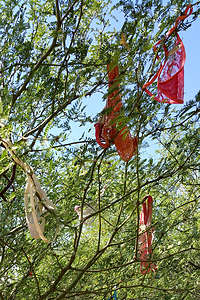 Thongs in the TreesAs had become customary when planning a few day stop, I would find the nearest on-route Walmart Supercenter and re-provision the bike for a few days of unsupported camping. I could probably have shopped anywhere, since I really couldn't carry much on the bike, but it was probably a holdover from our RV camping trips, and the familiarity of the Walmart shopping layout made it a bit more efficient shopping experience. A Subway for lunch, and I was back onto the road with a 12 pack of Bud strapped to the top the luggage bag.
Thongs in the TreesAs had become customary when planning a few day stop, I would find the nearest on-route Walmart Supercenter and re-provision the bike for a few days of unsupported camping. I could probably have shopped anywhere, since I really couldn't carry much on the bike, but it was probably a holdover from our RV camping trips, and the familiarity of the Walmart shopping layout made it a bit more efficient shopping experience. A Subway for lunch, and I was back onto the road with a 12 pack of Bud strapped to the top the luggage bag.
At the final turn to the "Ranch" I noticed some signage at the corner advertising the events at the local restaurant and saloon. At the top of a post, along with the usual beer ad's, and fundraisers, was a poster proclaiming in all CAPS, "MIDGET WRESTLING RETURNS". I had never heard of "midget wrestling", as either a sporting or spectator event, but alas the return date of May 15 would be well after my departure. This is probably just as well, and so I am still left unsure in the knowledge of whether I would or would not have attended the grand reopening and lost my "midget wrestling virginity".
 View from SummitAfter making camp, I spent the afternoon lounging at the pool, and strolling along the paths though the scrubs and desert. Along a river wash, I came along trail that included a collection of small plastic nymphs and other whimsical characters. They were nestled among the rocks and in the branches of trees, and actually looked like a bit of outdoor art. A bit further on, and I was greeted with a tree laced with lacy womens thongs. Also, a nice artistic touch, but one that I would not have expected to find in an otherwise isolated section of the desert.
View from SummitAfter making camp, I spent the afternoon lounging at the pool, and strolling along the paths though the scrubs and desert. Along a river wash, I came along trail that included a collection of small plastic nymphs and other whimsical characters. They were nestled among the rocks and in the branches of trees, and actually looked like a bit of outdoor art. A bit further on, and I was greeted with a tree laced with lacy womens thongs. Also, a nice artistic touch, but one that I would not have expected to find in an otherwise isolated section of the desert.
The next day, I knew that Lorry would chastise me if I did not get some real aerobic exercise. A large mountain was located directly behind my campsite, and I soon learned that there were trails to it's summit. Trail shoes on, I started out on a hike/run up the mountain.
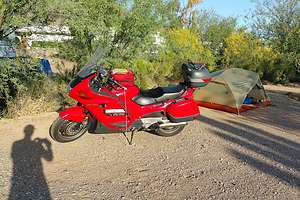 Campsite with HondaDistances are always a challenge to judge in the desert, and this mountain was no exception. It always seemed to recede, but eventually after 2.5 miles and 1000' of elevation gain, I was on it's summit. I had run with a bottle of water, but at this point the water was long gone.
Campsite with HondaDistances are always a challenge to judge in the desert, and this mountain was no exception. It always seemed to recede, but eventually after 2.5 miles and 1000' of elevation gain, I was on it's summit. I had run with a bottle of water, but at this point the water was long gone.
A few record photos, and I started to head back to the ranch.... or did I? From the summit, there was a maze of trails leading down, and the landscape below was homogenous enough that I didn't really know where to go? By checking the photos I had taken with the phone, I was finally able to retrace my steps, but it has been the last time that I have ever run without a gpx track being captured on my gps enabled phone or watch.
Well rested, it was with renewed enthusiasm for the road that I tidied up my gear in anticipation of the next days ride north, back to the epitome of cultured civilization, Las Vegas.
I40/Rt 66 to Flagstaff
Tuesday, May 5, 2015 - 3:30pm by Herb500 miles and 9.5 hours from our last stop - 1 night stay
Travelogue
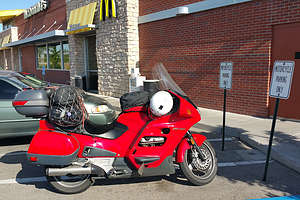 Respect from Ronald McDonaldStill on Central Time, I was up at 6:00 to be one of the first ones at breakfast. I normally enjoy a full breakfast at home, but on the road it seems almost essential to stock up with some high caloric waffles, eggs, bacon, and coffee of course.
Respect from Ronald McDonaldStill on Central Time, I was up at 6:00 to be one of the first ones at breakfast. I normally enjoy a full breakfast at home, but on the road it seems almost essential to stock up with some high caloric waffles, eggs, bacon, and coffee of course.
The bike was wet, but for now the skies where cloudy without any measurable precipitation. I entered the freeway and quickly got up to cruising speed. Skies were beautiful as the sun tried to poke through the morning clouds. Todays ride also held the promise of some elevation change. After riding 1000+ miles of flat Texas and Oklahoma I40, crossing the 7000' foot peaks in western New Mexico would be a treat.
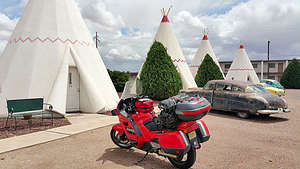 Wigwam Motel Teepees with BikeToday, route 66 has been largely superseded by I40. There remain lots of signage encouraging the traveler to exit and experience the legendary route 66, but most of these are simply efforts to encourage tourism on a bypass that otherwise has little to offer of substance.
Wigwam Motel Teepees with BikeToday, route 66 has been largely superseded by I40. There remain lots of signage encouraging the traveler to exit and experience the legendary route 66, but most of these are simply efforts to encourage tourism on a bypass that otherwise has little to offer of substance.
However,,, there was one stop on the original Route 66 that I wanted to try an visit. This was the legendary Wigwam Motel in Holbrook, AZ. I had seen photos of it's 28' concrete teepees and even considered spending a night in one.
But first, it was lunchtime and I experienced my first "motorcycle parking only" spot at an Albuquerque McDonalds. It was good to get some recognition as a long-distance motorcyclist if even only from Ronald MacDonald.
 Pee Break SelfieIn 150 miles further along I40 it was time for a pee break, which conveniently coincided with another R66 classic rest stop, the Arizona Painted Cliffs. The cliffs themselves are visible from the highway and invite a visit just from the natural beauty of the red sandstone cliffs. However, in classic Rt 66 tradition, natural beauty can always be enhanced, and this case it is done with the addition of full size sculptures of deer, elk, horses, teepees, and Indians, that dot the edges of the cliffs above. This is Navajo country and they seem to have learned how to merchandise their heritage with large signage announcing the "Lowest Prices on Indian Artifacts". I managed to avoid the gift shops and steered my trusty iron steed back out onto the highway.
Pee Break SelfieIn 150 miles further along I40 it was time for a pee break, which conveniently coincided with another R66 classic rest stop, the Arizona Painted Cliffs. The cliffs themselves are visible from the highway and invite a visit just from the natural beauty of the red sandstone cliffs. However, in classic Rt 66 tradition, natural beauty can always be enhanced, and this case it is done with the addition of full size sculptures of deer, elk, horses, teepees, and Indians, that dot the edges of the cliffs above. This is Navajo country and they seem to have learned how to merchandise their heritage with large signage announcing the "Lowest Prices on Indian Artifacts". I managed to avoid the gift shops and steered my trusty iron steed back out onto the highway.
After a few hours more, I exited I40 and got to the legendary Wigwam Motel. While I was too soon to stop for the night it was a good place to photograph some of the "classic cars" that adorned the parking lot outside of the Wigwams. Perhaps it was for best though, as it seemed as though the Wigwam Motel had seen it's better days, and was now just trying to hang onto the memories of whatever stature as a vacation destination that it once had.
 Tacos Los AltosI continued down I40, and at mile 500 pulled off in Flagstaff for as good cheap mexican dinner at Tacos Los Altos. Across the street was a Super 8 where I spent the night.
Tacos Los AltosI continued down I40, and at mile 500 pulled off in Flagstaff for as good cheap mexican dinner at Tacos Los Altos. Across the street was a Super 8 where I spent the night.
Morning at the Super 8 was the usual breakfast and pre-flight check of the bike before heading out for the days ride. However, this morning a girl loading her car in the parking lot noticed the NJ plate on my bike and seemed genuinely impressed that I had ridden the bike from NJ to Flagstaff. She even took a selfie with me and the bike to show to her boyfriend. It felt good to get an unsolicited confirmation that my cross-country ride might be something extraordinary.
I40 to Tucumcari
Monday, May 4, 2015 - 2:30pm by Herb438 miles and 8.5 hours from our last stop - 1 night stay
Travelogue
 Texas Style BBQFully revived from my two night stay and the services of an able masseuse I was once again, eager to hit the road.
Texas Style BBQFully revived from my two night stay and the services of an able masseuse I was once again, eager to hit the road.
Today ride didn't promise any spectacular scenery, and would hopefully be little more than blasting down the flat straight highway of I40 across the state of Texas. You knew your were in Texas when the Rest Area BBQ grates were in the shape of the state, and the Men's room had all caps TORNADO SHELTER signage as well.
This part of the country is, after all, also known as Tornado alley and weather was one of my major concerns on this stretch of road. Thankfully, I had had little in the way of rain on my trip so far. The forecast for the next few days showed a high likelihood of rain with thunderstorms, possibly severe, but not with any Tornados in the current forecast.
I headed out optimistically, and set my first destination as Cadillac Ranch in Amarillo, Texas. For those unfamiliar with Cadillac Ranch, this is basically an outdoor art exhibit on the ranch of Amariilo's helium magnate Stanley Marsh III. It consists of ten classic Cadillacs, buried nose first into the ground. Spray paint cans are usually found around the base of the vehicles, and visitors are encouraged to leave their own mark on the eclectic exhibit.
We had visited this as a family before in 2002 and curious readers can read Lolo's more detailed description at Cadillac Ranch, TX.
 Desert Cadillac Selfie with PhotobomberI parked my trusty steed sporting a NJ license plate, and strolled out to take the required cell phone selfie at the head of the line of Cadillacs.
Desert Cadillac Selfie with PhotobomberI parked my trusty steed sporting a NJ license plate, and strolled out to take the required cell phone selfie at the head of the line of Cadillacs.
Quickly back on the road I was up to my cruising speed of between 75 and 80 mph,, or so says my GPX track and Google Earth. I don't remember usually riding that fast, but there were some impressive storm clouds growing to the south, and I was hoping to outrun them before experiencing them first hand.
In fact, I was not the only one noticing the storm clouds to the south of my position on I40. Lorry had been tracking my progress on Google Maps, and had a weather radar window open as well. By checking them both, she could tell better than I could what my weather forecast would be.
The phone rang in my headset,, and I answered to hear Lolo offering mileages to the next few rest stops where I should stop and shelter out the storm that was rapidly approaching. Thanking her profusely, I headed toward the next rest area, but not before being caught in a deluge and gusty winds that threatened to blow me out of my lane. Within 15 minutes however I was safely in a rest area, enjoying a cup of bad coffee and listening to the rain pound on the ceiling above.
 Honda ST1100 under Ominous SkiesWithin a half hour, all was well again weatherwise and Lorry had another suggestion. We had never really done justice to Petrified Forest National Park, and since I would be passing right by, might I want to go and check it out. Maybe it was too late in the day, or maybe I was wanted to put in some miles, but for whatever reason I decided to blow off the Park and save it for another day. (Lorry and I did get a chance to go back to Petrified Forest National Park in 2016 when we drove the Camry cross country. It was a great visit, and I'm glad we go to do it together).
Honda ST1100 under Ominous SkiesWithin a half hour, all was well again weatherwise and Lorry had another suggestion. We had never really done justice to Petrified Forest National Park, and since I would be passing right by, might I want to go and check it out. Maybe it was too late in the day, or maybe I was wanted to put in some miles, but for whatever reason I decided to blow off the Park and save it for another day. (Lorry and I did get a chance to go back to Petrified Forest National Park in 2016 when we drove the Camry cross country. It was a great visit, and I'm glad we go to do it together).
I finally struggled into the town of Tucamari, NM. Got some gas and beer and checked into a Days Inn on the highway. Dinner was at the highly regarded "Blakes Lotaburger" where I tried my first green chile burger. After stolling back to the motel, and a few beers I was ready for bed but not before seeing the local weather forecast for tomorrow as "Thunderstorms in the morning, then partly cloudy during the afternoon hours. A few storms may be severe. High 73F. Winds S at 10 to 20 mph. Chance of rain 80%".
I fell into a deep sleep with the sound of rain blowing on my ground floor window.
I40 to Oklahoma City
Saturday, May 2, 2015 - 1:30pm by Herb168 miles and 4.5 hours from our last stop - 2 night stay
Travelogue
 Motorcycle Camping in OklahomaWhen I woke, it became painfully obvious that the lack of physical activity and long riding days were beginning to impact my vertebrae. Both my lower back and neck were complaining and I needed to do something soon to avoid being stuck in the midwest without the ability to ride my bike.
Motorcycle Camping in OklahomaWhen I woke, it became painfully obvious that the lack of physical activity and long riding days were beginning to impact my vertebrae. Both my lower back and neck were complaining and I needed to do something soon to avoid being stuck in the midwest without the ability to ride my bike.
A little research, and I found Oaklake Trails, a camping resort with a pool just short of Oklahoma City. In NJ I had become an avid pool swimmer at the local YMCA where by swimming 3 days a week, my back pain had diminished. I hoped that swimming might help loosen things up a bit.
I stocked up at the local Walmart, checked in, and pitched my tent in an open spot with a picnic table.
I had packed a small "Kermit" chair that I had first learned about when I met a motorcyclist in the Everglades who was using one for his circumnavigation of both the North and South American continents. While my riding goals were far more modest, I thought the chair comfortable as well and found it to be a great alternative to the motorcycle or beach chair. I sat down in the sun and read a bit from my Kindle.
A little swim in the pool and then a hike through the grounds ended the day.
 Oaklake Resort PoolThe next day I discovered that there was also a hot tub for campers to use. This seemed to help a bit to loosen up my shoulders but the pain persisted.
Oaklake Resort PoolThe next day I discovered that there was also a hot tub for campers to use. This seemed to help a bit to loosen up my shoulders but the pain persisted.
I got lucky when a professional masseuse set up his table by the pool and offered complimentary massages. While I had never had a massage in my life, and was somewhat reluctant to have a 40 year old guy rubbing my shoulders, I soon learned that he was a real professional. In fact, he had worked with the US Olympic team and had received an offer of a 6 figure salary to act as a personal masseuse for a couple in Florida. After 20 minutes of fairly intense manipulation of my shoulder blades I once again regained a complete range of motion. I was amazed, grateful, and insisted he take the $15 that was all I had on my person at the time.
With mobility restored, I could now return to planning the rest of my trip through the midwest. From previous crossings with our motorhome I was aware of the very real danger that weather, and particularly tornadoes present for travelers crossing Oklahoma and the Texas Panhandle during the late spring and early summer months. The immediate forecast looked OK for a crossing but I would have to make time since the following week looked very ominous. Lorry was concerned as well and assured me that she would monitor the radar map and keep me apprised of any storm cells.
I40 to Fort Smith
Friday, May 1, 2015 - 4:15pm by Herb523 miles and 11 hours from our last stop - 1 night stay
Travelogue
 Ground Floor Room at Super 8Up early, helped in part by the change to Central Time Zone, I was ready to put in some serious miles in my journey west.
Ground Floor Room at Super 8Up early, helped in part by the change to Central Time Zone, I was ready to put in some serious miles in my journey west.
As there really was no plan, I had considered stopping in Nashville but rejected it since I didn't enjoy riding in city traffic just to find expensive lodging. Also, it was too soon to stop for the day, and I had no real interest in country music. Finally, I feared feeling homesick when around crowds and/or in places that I knew that Lorry would enjoy.
Memphis, TN was the next city on route to be considered, but reluctantly rejected for much of the same reasons. Although, to this day I still wonder what it would have been like to visit Beale Street, the "Home of the Blues".
Instead, I headed west on I40 and after 5 hours had covered 250 miles and crossed the mighty Mississippi leaving Tennessee, and entering Arkansas. This river crossing, like all those before, seemed to mark the beginning of the trip into the "real west".
I immediately pulled over into the Arkansas welcome center to void my bladder, still wearing my earplugs, and charged to the mens room. When I exited, an older man that I think may have been trying to get my attention, continued to gesture and try to speak to me.
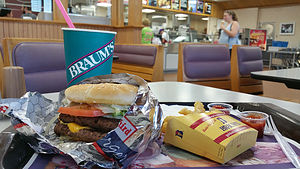 Tasty Braums Double BurgerHis intention now obvious, I removed my earplugs and was surprised to learn that he was seeking me out to hand out brochures extolling the virtues of Arkansas' twisty motorcycle roads. It seems that there is a considerable tourist business catering to motorcyclists. I explained that I was just passing through, but would consider his offer on my next trip through his state.
Tasty Braums Double BurgerHis intention now obvious, I removed my earplugs and was surprised to learn that he was seeking me out to hand out brochures extolling the virtues of Arkansas' twisty motorcycle roads. It seems that there is a considerable tourist business catering to motorcyclists. I explained that I was just passing through, but would consider his offer on my next trip through his state.
After 5 more hours I finally pulled into Fort Smith Arkansas, the last town on I40 before Oklahoma, and one that we had actually visited in the motorhome with family in 2002. In fact, it was the last of the lower 48 states that we visited with our boys in the Lazy Daze, and completely filled in the "sticky state map" on the interior of our coach's door.
It was a full day of 523 miles, but my timing probably could have been better. Fort Smith was hosting a major gathering of motorcyclists, (mostly Harley riders), and almost all the motels were full.
I pulled into the 2 star rated Super 8 Van Buren/Ft. Smith Area in hope of getting a ground floor room as I always had so that I could easily unpack my bike and keep it secure. The receptionist encouraged me to take a second floor room, but then offered that there might be one left if I didn't mind a bit of noise.
After unpacking and showering I walked to the highly rated Braum's Ice Cream & Burger Restaurant for their specialty double burger and milkshake. Judging from the average girth of their clientele they must be doing a good business.
Finally back in my room I understood the receptionists desire to get me on the second floor. Even with the aid of silicon earplugs and a few beers I couldn't avoid the sounds of celebration in the room above my room.
Oh well,,,
Cades Cove Loop to Lebanon
Thursday, April 30, 2015 - 1:15pm by Herb262 miles and 8.75 hours from our last stop - 1 night stay
Travelogue
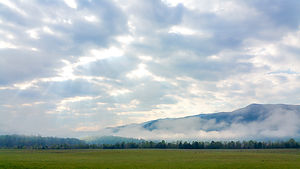 Cades Cove MeadowSomewhat groggy from the previous nights excesses, I tried to come up with a riding plan for the day.
Cades Cove MeadowSomewhat groggy from the previous nights excesses, I tried to come up with a riding plan for the day.
Many cups of coffee later my will re-materialized and I realized that I would forever regret it if I did not take a ride through Cades Cove. It was most certainly the only time in my life that I would be able ride this on my motorcycle, and probably the first or second thing that friends would ask when they learned I visited the Great Smoky Mountains National Park. So, I decided to go, even though it would involve a 4 hour detour back through the park.
Once again, timing was in my favor. While I had heard horror stories of "bumper to bumper" traffic throughout the entire loop during autumn, on this early weekday morning in April, I almost had the entire loop to myself.
The clouds hung low over the Cove, but no rain materialized. Instead, I was treated to sunbeams breaking through the clouds and illuminating the morning fog in the meadows.
 Honda ST1100 SupermodelI posed my trusty steed in an empty parking lot, and photographed her under the soft light with sunbeams in the distance as if she were a supermodel.
Honda ST1100 SupermodelI posed my trusty steed in an empty parking lot, and photographed her under the soft light with sunbeams in the distance as if she were a supermodel.
A little further on the loop I strolled around the grounds of the Cable Mill Visitors Center and photographed the gristmills.
OK,, I now had to make up some time and start riding west on I40. Coming out of Gatlinburg I had to pass directly through Pigeon Forge of Dollywood Fame. The entrance to the park was enormous with parking lots as far as the eye could see. I was glad that it was off-season and that without traffic I could make good time to Knoxville. I cannot imagine what this would be like in the height of the summer tourist season.
At Knoxville, Lorry had found another Chipotle so I set that as my destination and had my second lifetime dubious Chipotle lunch.
Full of beans, I headed west on I40 and tried to make up some time.
After a while, I found an Econo Lodge in Lebanon, Tennessee that was in walking distance to a highly Yelped restaurant named Los Compadres Mexican Grill. So after another dose of Mexican food I was sated and soon asleep in my room.
Great Smokies to Gatlinburg
Wednesday, April 29, 2015 - 12:15pm by Herb130 miles and 6 hours from our last stop - 1 night stay
Travelogue
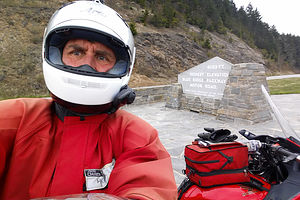 Highest Point on the Blue Ridge ParkwayWell rested and restored from my visitation to Biltmore Estate, I set out to plan the next few days of the trip. The Trader Joes stop had supplied both food and drink for a few days of unsupported travel so I could camp as well.
Highest Point on the Blue Ridge ParkwayWell rested and restored from my visitation to Biltmore Estate, I set out to plan the next few days of the trip. The Trader Joes stop had supplied both food and drink for a few days of unsupported travel so I could camp as well.
The original plan was to head over to Deals Gap and try to ride the "Tail of the Dragon" the next day. However, the weather forecast was for a slight drizzle for most of the day. In addition, the stop would probably add a day or two to the overall trip. Finally, I had already experienced some extreme twisties on my fully loaded bike through an inadvertent turn into a road that was posted as the "most crooked road in Virginia". With steep descents, horseshoe decreasing radius turns, and narrow lanes it was not an experience that I would intentionally repeat. Thus, I programmed the bike to head to Gatlinburg, Tennessee.
Those who know me might wonder why I would possibly subject myself to a monumental tourist trap, especially when the ride would take me directly through the Great Smoky Mountains National Park, where I probably could have camped and taken a ride through a highlight of the park, the "Cades Cove Loop".
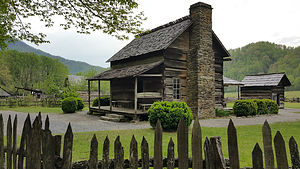 Mountain Farm MuseumThe misting rain played a large part in my decision, and I figured that I could always backtrack a bit on the next day to do the Loop under better weather conditions. So I returned again to the last of my ride along the Blue Ridge Parkway.
Mountain Farm MuseumThe misting rain played a large part in my decision, and I figured that I could always backtrack a bit on the next day to do the Loop under better weather conditions. So I returned again to the last of my ride along the Blue Ridge Parkway.
I arrived at the Richland Balsam Overlook, which at 6053 feet, is the highest point along the parkway. A quick selfie and I was back on the road.
Next stop was the Oconaluftee Visitor Center in Cherokee, NC. It was a great spot for a break and to have a bit of lunch. I strolled through the adjoining Mountain Farm Museum and took some photos of the relocated dwellings from the 1800's. Despite the intermittent drizzle, the parking lot was full of motorcycles setting out to enjoy the twisty roads through the Great Smoky Mountains National Park. As I don't like riding in a group, or being in front of a group, I waited till they had a bit of a head start, and then headed out myself.
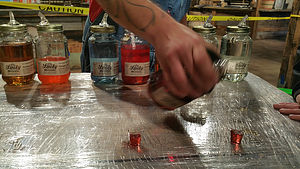 Moonshine Tasting ShotletsThe ride was thoroughly enjoyable, although I did give a thanks to the folks at Aerostich in Duluth, Minnesota who had the made the expensive, but very waterproof Darian Jacket and Pants that I was now my daily "office wear". Although they cost over $800 new, I consider it a good value since it has protected my butt and other vital body parts for over 40K miles through rain, sun, freezing and desert hot temperatures.
Moonshine Tasting ShotletsThe ride was thoroughly enjoyable, although I did give a thanks to the folks at Aerostich in Duluth, Minnesota who had the made the expensive, but very waterproof Darian Jacket and Pants that I was now my daily "office wear". Although they cost over $800 new, I consider it a good value since it has protected my butt and other vital body parts for over 40K miles through rain, sun, freezing and desert hot temperatures.
In far too short a time, I arrived at the kitschy tourist trap of Gatlinburg Tennessee. I wasn't sure what I had expected, but what I found was a very nice, clean, community filled with enough tourist attractions to fulfill the vacation fantasies of its millions of annual visitors. Fortunately, on an April weekday I was ahead of the crowds and pretty much had the place to myself.
I quickly secured lodging at an Econo Lodge Inn & Suites at the Convention Center, which was in walking distance to the main tourist drag and had a burger dinner at the Smoky Mountain Brewery.
Satisfied, I started my stroll down the main strip to see what adventures would await me.
 Ripley's Believe It or Not! OdditoriumI lost my "moonshine virginity" at Ole Smoky Moonshine. It was an open air bar built to handle patrons 10 deep, but during this evening it was myself and a few other "tasters". I "think" it was free since I can't find any record of a charge and I also "think" that they offered up to 10 little "shotlets" of liquor that they labeled for the tourist trade as "moonshine".
Ripley's Believe It or Not! OdditoriumI lost my "moonshine virginity" at Ole Smoky Moonshine. It was an open air bar built to handle patrons 10 deep, but during this evening it was myself and a few other "tasters". I "think" it was free since I can't find any record of a charge and I also "think" that they offered up to 10 little "shotlets" of liquor that they labeled for the tourist trade as "moonshine".
Feeling warmed up, I continued down the street and found Davy Crocketts Moonshine. To my surprise, it was the same deal here. Stand at the bar and wait for a bunch of little shot glasses of moonshine to be delivered without cost?
Finally, in what can only be considered as an irrational act of excess, I found the last remaining moonshine emporium on the block. Doc Collier Moonshine provided the same deal as the rest, and I almost certainly should have declined. But... when in Rome..
I staggered back to my room, drank some water, and went to sleep....
Blue Ridge Parkway to Ashville
Monday, April 27, 2015 - 2:00pm by Herb210 miles and 8 hours from our last stop - 2 night stay
Travelogue
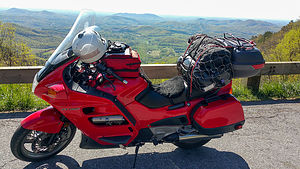 ST 1100 at Cumberland Knob Recreation area overlookAfter two nights on the road, I was beginning to get into a bit of a rhythm. The "laundry", consisting of a pair of e-officio underwear, wool socks, and a long sleeve wool shirt which were washed in the sink with shampoo, and dried overnight using the motel rooms heater. Nourishment in the form of 2 packs of Maple and Brown Sugar Oatmeal and a mug of coffee were prepared using hot water from the microwave or coffee maker.
ST 1100 at Cumberland Knob Recreation area overlookAfter two nights on the road, I was beginning to get into a bit of a rhythm. The "laundry", consisting of a pair of e-officio underwear, wool socks, and a long sleeve wool shirt which were washed in the sink with shampoo, and dried overnight using the motel rooms heater. Nourishment in the form of 2 packs of Maple and Brown Sugar Oatmeal and a mug of coffee were prepared using hot water from the microwave or coffee maker.
My clothes were contained in a black waterproof "river bag" that was strapped on top of a waterproof black Ortlieb bag which contained all the soft camping gear. (Big Agnes UL3 Tent, Mountain Hardware Ultralamina 32 sleeping bag, luxurious X-Ped large sleeping pad, and a Kermit camping chair.)
The rest of the bike was packed as follows...
- Left side saddlebag inner compartment - Nalgene water bottle, Jetboil cookset and Jetboil stove, Starbucks Italian Coffee, and a Nissan thermos.
- Left side saddlebag outer compartment - Propane, Bagels, Peanut butter, Quaker instant oatmeal, and a partial roll of paper towels
- Right side saddlebag inner compartment - Small soft cooler with beer, water bottles, wine in Arizona green tea bottles
- Right side saddlebag outer compartment - Progresso canned soup, purple mist Gatorade, Triscuits, Knorrs Rice Sides, Mountain House dinners, and a bag of cashews
- The rear Givi bag contained my Canon G12 camera, a Go-Pro, a small laptop, AAA maps of the country by state, and my Gerbing Heated Jacket when it was not needed to be worn.
- The tankbag contained my chargers for the phone, headset, and GPS, as well as a cover for the entire bike. A map for the current section was visible in the top clear pouch.
My pre-flight routine had also been refined somewhat.
- Start the bike and let it warm up while finishing the packing process
- Get Google Maps on the phone positioned to the next destination, start the Strava application to record the gpx track, and create a playlist for the day on Google Music
- Check tires, lights, and all controls
- Plug in heated jacket and adjust the vents on my Aerostich Darien Jacket for the forecasted temperatures in the early morning.
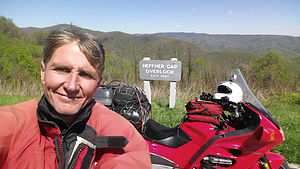 Bad Helmet Hair SelfieToday would be a great ride. I was heading down some of the most scenic parts of the Blue Ridge Parkway and Lorry had convinced me that I should treat myself with a few days in Ashville so I could visit the Biltmore Estate. Living in NJ we had often visited the Mansions of Newport Rhode Island, but had not yet visited the largest of the Vanderbilt Mansions. I wished that Lorry could be here with me, but I promised to take a lot of photos so she could vicariously enjoy the tour with me.
Bad Helmet Hair SelfieToday would be a great ride. I was heading down some of the most scenic parts of the Blue Ridge Parkway and Lorry had convinced me that I should treat myself with a few days in Ashville so I could visit the Biltmore Estate. Living in NJ we had often visited the Mansions of Newport Rhode Island, but had not yet visited the largest of the Vanderbilt Mansions. I wished that Lorry could be here with me, but I promised to take a lot of photos so she could vicariously enjoy the tour with me.
On the road one again, I enjoyed the two lane Blue Ridge Parkway that meandered down the ridge of the mountains past rolling hills and occasional farm fields. After 45 minutes I pulled over at the Cumberland Knob Recreation area overlook and photographed my trusty steed with the mountains in the distance.
 Biltmore EstateAs I continued on, I got a call from Lolo with a suggestion for lunch. She had grown somewhat concerned with my diet so far on this trip, and had found what she thought might be a more healthy fast food alternative. By tracking my projected progress she directed me to a Chipotle in Boone, N.C. At the time I had never eaten in a Chipotle so I headed off the parkway to enjoy a "healthy" mexican style lunch. I have to say that it was tasty,, but by the time I had finished adding sour cream and other embellishments I am sure it was a high caloric meal of with dubious health qualities. (This was before the recent norovirus outbreak would have made this choice of dining venue even more questionable.)
Biltmore EstateAs I continued on, I got a call from Lolo with a suggestion for lunch. She had grown somewhat concerned with my diet so far on this trip, and had found what she thought might be a more healthy fast food alternative. By tracking my projected progress she directed me to a Chipotle in Boone, N.C. At the time I had never eaten in a Chipotle so I headed off the parkway to enjoy a "healthy" mexican style lunch. I have to say that it was tasty,, but by the time I had finished adding sour cream and other embellishments I am sure it was a high caloric meal of with dubious health qualities. (This was before the recent norovirus outbreak would have made this choice of dining venue even more questionable.)
Fueled up, I headed back to the Parkway and almost immediately pulled over to stroll around the Moses H. Cone Memorial Park. A few photos, and the next pullout was at the Hefner Gap Overlook at elevation 3067 where a "bad helmet hair" selfie was taken. I had already been over the Pilot Ridge Overlook with an elevation of over 4000' so the heated jacket was dialed up even though I was in North Carolina and had thought I would be enjoying warmer weather.
 Biltmore Estate GardensThe Ridge Junction at 5160' was the next stop and then off to the Craggy Gardens Visitor for a quick pee break. I met a couple of older guys there on BMW GS 1200's that were on their way to a BMW camping event so they could ride the "Tail of the Dragon" near Deals Gap. For those unfamiliar with this road, with "318 curves in 11 miles" it is considered one of the top 5 rides in the world, and one that I would try to get to in a few days.
Biltmore Estate GardensThe Ridge Junction at 5160' was the next stop and then off to the Craggy Gardens Visitor for a quick pee break. I met a couple of older guys there on BMW GS 1200's that were on their way to a BMW camping event so they could ride the "Tail of the Dragon" near Deals Gap. For those unfamiliar with this road, with "318 curves in 11 miles" it is considered one of the top 5 rides in the world, and one that I would try to get to in a few days.
After a few more miles I managed to navigate to the Super 8 in Ashville where I would spend the next two nights, allowing for a "rest day" where I could tour the Biltmore estate.
Up early in the morning I rode for the first time on this trip, without the extra burden of all my extra luggage. It felt liberating and simpler even as I navigated my way to the ticket area of the Biltmore Estate. Lorry had researched this and already purchased my ticket for a Tour of the Mansion at 11:30.
 Women in Period Costumes at Biltmore EstateStrolling the beautiful gardens and the interior of the mansion I started to feel a bit lonesome for the companionship of my lifelong partner. When riding long distances on the motorcycle I have no longings since I know that Lorry would not actually enjoy the experience as much as I do. However, I know that she would enjoy a good Mansion Tour and stroll in the gardens so I had to make do with a phone call where I tried to give her the best virtual description I could.
Women in Period Costumes at Biltmore EstateStrolling the beautiful gardens and the interior of the mansion I started to feel a bit lonesome for the companionship of my lifelong partner. When riding long distances on the motorcycle I have no longings since I know that Lorry would not actually enjoy the experience as much as I do. However, I know that she would enjoy a good Mansion Tour and stroll in the gardens so I had to make do with a phone call where I tried to give her the best virtual description I could.
The Mansion was as impressive as expected, but the volume of tourists made it a bit crowded. Also, I had become accustomed to going my own way as a solo traveler and now had to adapt to being just another of the many cattle herded around from room to room.
Afterwards I had a stroll in the gardens and sat down on a bench by the lake for a snack. My phone rang and Lolo asked me how I was enjoying the view (she could see me location on Google maps). That cheered me up a bit as I described the scene in front of me.
I took a bit of a detour while leaving the estate to enjoy the grounds, stopped at a Trader Joe's in Asheville to replenish my stores, and got back to my room in time to rest up for the next days journey west.
Skyline Drive to Fancy Gap
Sunday, April 26, 2015 - 3:00pm by Herb304 miles and 9 hours from our last stop - 1 night stay
Travelogue
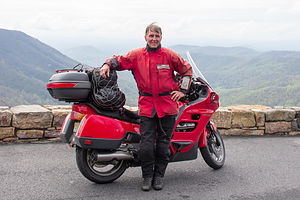 Herb with Honda ST1100 at Bacon Hollow OverlookWith the aid of a few beers that were still cold from home, I managed to have a pretty good first nights sleep in my frugal motel. Upon awakening, the coffee maker yielded enough hot water for an instant oatmeal breakfast, and enough coffee to fuel me and my thermos for the day.
Herb with Honda ST1100 at Bacon Hollow OverlookWith the aid of a few beers that were still cold from home, I managed to have a pretty good first nights sleep in my frugal motel. Upon awakening, the coffee maker yielded enough hot water for an instant oatmeal breakfast, and enough coffee to fuel me and my thermos for the day.
Today promised to be a good one. The weather was overcast, and I was poised at the start of the Skyline Drive in Front Royal. Yesterday had been a day of mostly congested highway traffic trying to get out of the NY and Philadelphia metropolitan areas. This should be the start of the "fun part" of the trip without the congestion of the northeast, and into the pretty twisting road that l had imagined when I first planned the trip.
It would have been easier and shorter to just head to San Francisco on I80, as we had done numerous times before in the Lazy Daze, but this was to be a motorcycle trip. One where I could enjoy all the twisty narrow roads on 2 wheels instead of fighting them in the 6 wheels and 7 tons of the motorhome. Besides, I this was probably my last opportunity to motorcycle on the east coast and I didn't want to leave without trying some of the "classic best motorcycle roads" that had escaped me for the last 40 years.
 Mabry MillSpeaking of tonnage, my fully laden steed probably tipped the scales with a full tank of gas at close to 800 lbs. Once moving, the weight magically seems to disappear, but it would immediately return when stopping and/or attempting a slow speed turn. In addition, it was nearly impossible to push backwards up the slightest of inclines so I would have to be careful that I always parked the bike in a spot where the gradient would work in my favor when departing.
Mabry MillSpeaking of tonnage, my fully laden steed probably tipped the scales with a full tank of gas at close to 800 lbs. Once moving, the weight magically seems to disappear, but it would immediately return when stopping and/or attempting a slow speed turn. In addition, it was nearly impossible to push backwards up the slightest of inclines so I would have to be careful that I always parked the bike in a spot where the gradient would work in my favor when departing.
I headed out before nine and managed to ride for 1.5 hours to arrive at the Harry F. Byrd, Sr. Visitor Center at milepost 51 for a long anticipated pee break. It was great riding, but it felt good to get off of the bike and stretch a bit. The road was beautiful, but twisty and the posted speed limit kept my average speed well below 40mph.
After 20 more miles I stopped at Bacon Hollow Overlook for a few photos of my bike with the misty mountains in the backdrop. Someone notice me taking an awkward selfie with the phone, and I was able to have him take a real photo with my Canon G12 of myself with the bike.
I soon ran out of Skyline Drive and headed west to Staunton where I could get on I81 and make up some time going south to the better parts of the Blue Ridge Parkway. Technically, the Blue Ridge Parkway starts pretty much at the end of Skyline Drive, but I had read the the best parts of 469 mile park were actually the southern section, so in the interest of time efficiency I bypassed this section and barreled south on I81 past Roanoke, and south at Christiansburg towards the Mabry Mill in the Meadows of Dan.
 Disturbing Morning Selfie in Country View InnFrom earlier research I had found that the Mabry Mill at milepost 176 is considered one of the most picturesque locations on the entire parkway. As an amateur photographer, it was a location that I did not want to bypass.
Disturbing Morning Selfie in Country View InnFrom earlier research I had found that the Mabry Mill at milepost 176 is considered one of the most picturesque locations on the entire parkway. As an amateur photographer, it was a location that I did not want to bypass.
The Mill did not disappoint, and I spent some time there composing the usual Mill shots, and some arm's length selfies. The cloud cover gave great diffused lighting and spirits were high.
As I rode south I would occasionally come across signage on private farmland extolling me to Repent, and/or otherwise seek forgiveness for my sins. This seems to be a shared sentiment among many farmers throughout the country though I had never seen it in this part of the south before. While I am not personally involved with any organized religion, I did try to understand why some portions of the country and perhaps farmers in particular are more demonstrative in their religious beliefs.
Meanwhile, I soon needed a place to stay for the night, and Lorry had found the the Country View Inn in Fancy Gap which was just off the Parkway. I rolled into the parking lot, checked in, and was soon sheltered in a cozy room, complete with Bible opened to Hosea 9-11. I tried not to take it personally.
Front Royal
Saturday, April 25, 2015 - 2:45pm by Herb323 miles and 7.5 hours from our last stop - 1 night stay
Travelogue
 Up the Block to Start the TripAs an electrical/computer engineer of Germanic descent, it might be obvious that I would be a bit of a perfectionist, maybe a bit stubborn, and one who prefers to "do it all yourself", instead of depending upon the supposed expertise of others. I also have almost a clinical fear of failure and/or being made to feel like a fool.
Up the Block to Start the TripAs an electrical/computer engineer of Germanic descent, it might be obvious that I would be a bit of a perfectionist, maybe a bit stubborn, and one who prefers to "do it all yourself", instead of depending upon the supposed expertise of others. I also have almost a clinical fear of failure and/or being made to feel like a fool.
As such, once the idea of this trip had been solidified, I started the process of trying to maximize my chances for a safe, uneventful, and enjoyable journey cross the continent. Both the bike and myself would need to be in top condition. I had the month of March and most of April to finalize my preparations.
My own physical condition was basically sound, as both Lorry and I regularly exercise daily throughout the year. However, I do have some spinal challenges. My lower back L4/L5 when misaligned can develop severe sciatica down to the left toe, and my neck C3/C4 vertebrae result in numbness in two fingers of my right hand. Sitting on a motorcycle without much opportunity for exercise could certainly aggravate both conditions.
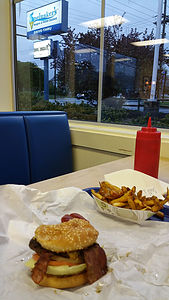 Spelunker Burger DinnerSo,,, for the 5 weeks prior to the trip I would take extended rides once or twice a week on my bike into the Catskills and along the Delaware river from our home in northern NJ. I started off with just a hundred miles, and worked up to 350 miles prior to starting the trip. Fortunately, I had a Gerbing heated motorcycle jacket and heated grips on the bike that allowed me to ride even when the temperature dropped below freezing. I even had to dodge a snowstorm once in the Catskills before returning the the relative safety of I95 and the slab of highway for the ride back home.
Spelunker Burger DinnerSo,,, for the 5 weeks prior to the trip I would take extended rides once or twice a week on my bike into the Catskills and along the Delaware river from our home in northern NJ. I started off with just a hundred miles, and worked up to 350 miles prior to starting the trip. Fortunately, I had a Gerbing heated motorcycle jacket and heated grips on the bike that allowed me to ride even when the temperature dropped below freezing. I even had to dodge a snowstorm once in the Catskills before returning the the relative safety of I95 and the slab of highway for the ride back home.
My Bike, a Honda ST-1100 with a water cooled V4 engine that I purchased new in 1996 also needed to be in top shape for the trip. While it had over 40K uneventful miles on the odometer, there were still a few things I needed to take care of before this trip.
First on the list of bike maintenance was the brakes. This particular bike, especially when ridden over salted winter roads has a tendency to develop corrosion in the aluminum brake calipers where the piston seals are seated. As such, the brakes may seize in the ON mode at the most inopportune time, resulting in continuous breaking and possible overheating of the brake disks. Don't ask me how I know that it costs $450 for a replacement front disc. Anyway, I did a complete rebuild of all brake pistons, seals, and front and rear calipers.
I also changed all brake and clutch fluids, rear differential fluid, and cooling fluids. Spark plugs, air filter, and battery were also replaced. Finally, the rear drive shaft gearing was lubricated and wheels removed for new tires and balancing at the local Honda motorcycle dealership. FWIW, tire changes where the only maintenance items that I had performed by a dealer in almost 20 years of ownership.
I also put together a comprehensive repair kit of tools, spares, and even tire compressor and patch kit that I hoped would keep me on the road in case of mechanical failure.
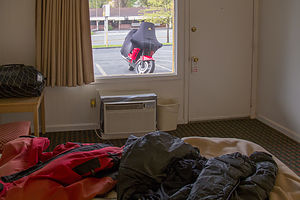 Scottish Inns RoomI put together a packlist and organized my gear in both side saddle bags, the rear GIVI bag, front tank bag, and two waterproof duffle bags that held clothes and camping gear. The plan was to motel it most days, but camp out whenever a beautiful warm opportunity presented itself.
Scottish Inns RoomI put together a packlist and organized my gear in both side saddle bags, the rear GIVI bag, front tank bag, and two waterproof duffle bags that held clothes and camping gear. The plan was to motel it most days, but camp out whenever a beautiful warm opportunity presented itself.
When the day of departure finally arrived it was with a mix of excitement, anticipation, and mild fear that I kissed Lolo and started riding up our block towards the west coast. We had rarely been apart for this length of time during our 30 years of marriage so I was uncertain if loneliness would be a factor. Fortunately, modern electronics once again would help. I had a new Sena motorcycle audio system with which I could use the cell phone to both navigate, play music, and also call Lolo periodically for updates. In addition, we were location sharing on Google Maps so that Lorry could literally track my progress on computer monitor. This would prove to be quite useful when crossing Texas.
Day one went pretty much as planned. I rode from our home south down 287, across the Delaware River on 78, to 81 past Allentown PA, Harrisburg PA, and eventually to the Scottish Inns in Front Royal, VA. This was primary interstate highways which Lorry and I had done once before so it was pretty uneventful. It did serve the purpose however of positioning me at the start of the scenic Skyline Drive which would be the highlight for tomorrow.
